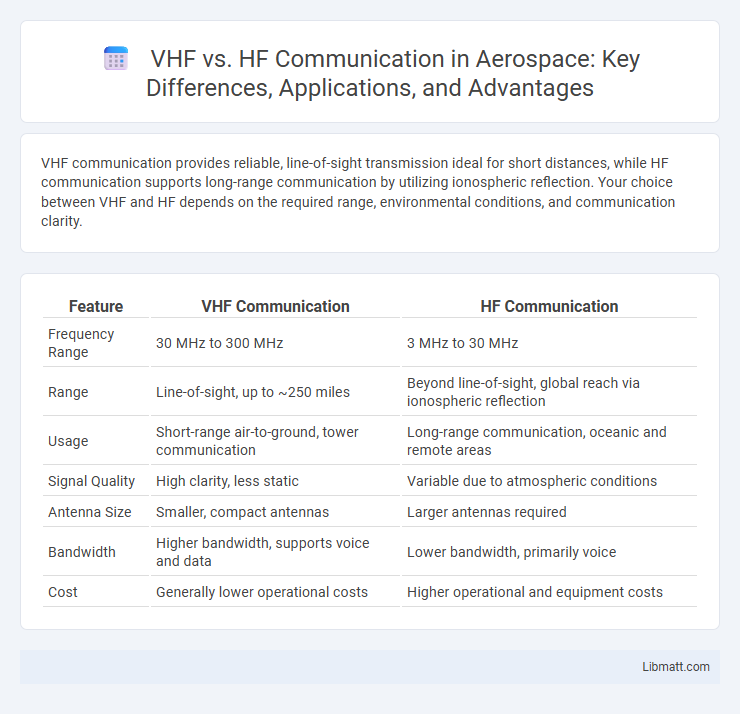VHF communication provides reliable, line-of-sight transmission ideal for short distances, while HF communication supports long-range communication by utilizing ionospheric reflection. Your choice between VHF and HF depends on the required range, environmental conditions, and communication clarity.
Table of Comparison
| Feature | VHF Communication | HF Communication |
|---|---|---|
| Frequency Range | 30 MHz to 300 MHz | 3 MHz to 30 MHz |
| Range | Line-of-sight, up to ~250 miles | Beyond line-of-sight, global reach via ionospheric reflection |
| Usage | Short-range air-to-ground, tower communication | Long-range communication, oceanic and remote areas |
| Signal Quality | High clarity, less static | Variable due to atmospheric conditions |
| Antenna Size | Smaller, compact antennas | Larger antennas required |
| Bandwidth | Higher bandwidth, supports voice and data | Lower bandwidth, primarily voice |
| Cost | Generally lower operational costs | Higher operational and equipment costs |
Introduction to VHF and HF Communication
VHF (Very High Frequency) and HF (High Frequency) communication operate on different radio frequency bands, with VHF typically ranging from 30 MHz to 300 MHz and HF spanning 3 MHz to 30 MHz. VHF signals are known for line-of-sight transmission, offering reliable, clear communication over shorter distances, ideal for marine, aviation, and emergency services. HF communication enables long-distance radio transmission by reflecting signals off the ionosphere, making it essential for international broadcasting, military communication, and remote area connectivity.
Frequency Ranges: VHF vs HF
Very High Frequency (VHF) operates within the 30 MHz to 300 MHz range, facilitating short to medium-range communication with relatively high clarity and minimal interference. High Frequency (HF) spans 3 MHz to 30 MHz, enabling long-distance communication by reflecting signals off the ionosphere, which is ideal for maritime and aviation applications. The distinct propagation characteristics of VHF and HF frequencies determine their suitability for different communication needs, with VHF preferred for line-of-sight and HF for beyond-line-of-sight transmissions.
Propagation Characteristics
VHF communication operates primarily in the 30 MHz to 300 MHz range, enabling line-of-sight propagation ideal for short to medium distances, typically up to 100 miles depending on terrain and antenna height. HF communication spans 3 MHz to 30 MHz and utilizes ionospheric reflection, supporting long-distance communication over thousands of miles by bouncing signals off the atmosphere. Understanding these distinct propagation characteristics can help optimize your communication system based on range requirements and environmental factors.
Equipment and Antenna Requirements
VHF communication requires compact, less complex equipment and shorter antennas, typically around 1 to 3 meters, making it ideal for line-of-sight transmissions in urban or maritime environments. HF communication demands more sophisticated radios with advanced modulation capabilities and larger antennas, often spanning tens of meters, to support long-distance, ionospheric signal propagation. Your selection between VHF and HF equipment hinges on the intended communication range and installation space limitations.
Signal Range and Coverage
VHF communication operates within the 30 MHz to 300 MHz frequency range, providing reliable line-of-sight signal coverage typically up to 30 to 50 miles, ideal for short to medium-range transmissions. HF communication uses frequencies between 3 MHz and 30 MHz, enabling long-distance signal propagation over hundreds to thousands of miles through ionospheric reflection and skywave propagation. VHF signals offer better penetration in urban environments, while HF excels in global coverage but is more susceptible to atmospheric disturbances and signal fading.
Typical Applications and Use Cases
VHF communication is commonly used for short-range applications such as marine navigation, aviation communication, and emergency services due to its reliable line-of-sight transmission. HF communication enables long-distance and over-the-horizon communication, making it ideal for military operations, international broadcasting, and remote area connectivity. Your choice between VHF and HF depends on whether you need short-range clarity or extensive reach for communication.
Interference and Signal Quality
VHF communication operates at higher frequencies, resulting in clearer signals with less atmospheric interference compared to HF, which is prone to ionospheric distortions and static noise. HF signals can travel longer distances by reflecting off the ionosphere but often suffer from fading and signal degradation during solar storms. VHF's line-of-sight transmission offers more reliable signal quality for short-range communication, making it ideal for marine and aviation use where minimal interference is crucial.
Regulatory and Licensing Considerations
VHF communication operates primarily within the 30 MHz to 300 MHz frequency range and typically requires specific licensing from national regulatory bodies such as the FCC in the United States, often with stricter power and antenna restrictions due to line-of-sight transmission limitations. HF communication, spanning 3 MHz to 30 MHz, involves more complex licensing procedures focused on international coordination through bodies like the International Telecommunication Union (ITU), due to its long-range propagation characteristics and potential interference with global frequencies. Compliance with these regulatory frameworks is essential to avoid fines and ensure lawful operation, with HF licenses often demanding more detailed technical justification and adherence to band plans.
Cost, Accessibility, and Practicality
VHF communication typically offers lower costs for equipment and maintenance compared to HF systems, making it more accessible for everyday users such as marine or aviation operators. VHF signals provide practical, clear line-of-sight communication ideal for short to medium distances, whereas HF communication covers long-range communication but demands more expensive, complex equipment and higher operational knowledge. Your choice between VHF and HF should consider budget constraints, range requirements, and ease of use in specific environments.
Choosing the Right Communication Solution
Selecting the appropriate communication solution between VHF and HF depends on factors such as range, frequency, and application environment. VHF (Very High Frequency) excels in short-range line-of-sight communication, ideal for maritime, aviation, and local emergency services, while HF (High Frequency) supports long-distance communication by reflecting off the ionosphere, suitable for remote or offshore operations. Evaluating operational needs, signal propagation, and regulatory limitations ensures an effective and reliable communication system tailored to specific scenarios.
VHF vs HF Communication Infographic

 libmatt.com
libmatt.com